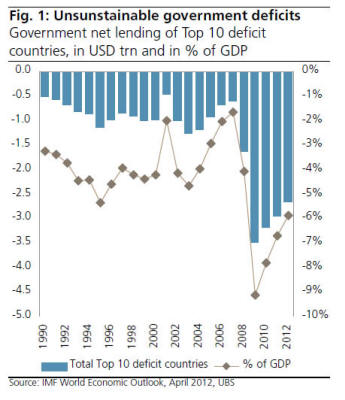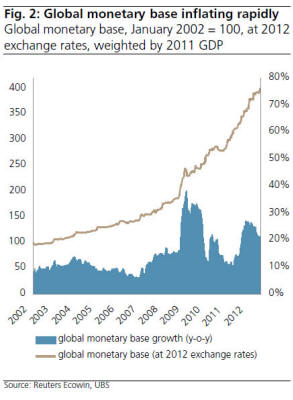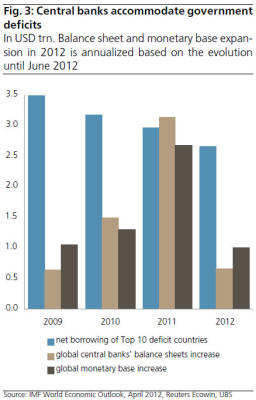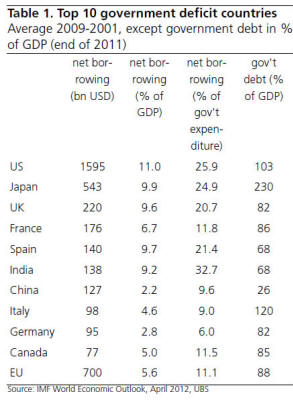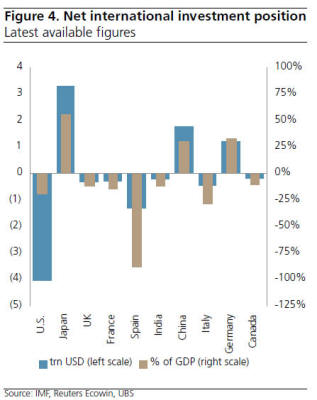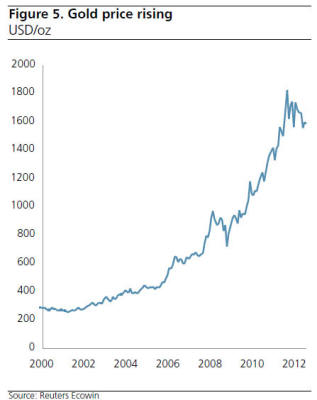|
by Tyler Durd
Supposedly warnings about the latent inflationary threat posed by simply ridiculous non-financial debt levels (as presented most recently here yesterday), not to mention financial debt (which as MF Global's rehypothecated implosion demonstrated so vividly can be any number between minus and plus infinity, thank you London "regulators") from the blogosphere can be ignored ($15 trillion melting ice cube that is shadow banking which also doubles as the best inflationary buffer known to man, notwithstanding).
After all, what does the blogosphere know:
But when these same warnings emanate from the "very serious people" at UBS, economists with a Ph.D. at that, it may be a little more difficult to dismiss them.
So here it is: "Hyperinflation Revisited" from
Caesar Lack, PhD, economist.
Our monthly global inflation barometer tracks the risks to our global inflation outlook as part of our “Global risk watch” series.
Apart from deflation and high inflation, we identify hyperinflation
as a third risk to our view of moderate global inflation rates. We currently
see it as very unlikely that any of these three risk scenarios will
materialize over the next 12 months, i.e. we estimate their probability at
below 10%. However, given the devastating effects hyperinflation would have,
we want to explore the risk of hyperinflation in more detail.
Peter Bernholz notes that historically, cases of hyperinflation have been preceded by the central bank monetizing a significant proportion of the government deficit.
After investigating 29 hyperinflationary episodes, 28 of which happened in the 20th century, Bernholz writes:
When government deficits become unsustainable, austerity is often the first reaction.
Austerity is deflationary, recessionary, and painful. If the
austerity necessary to balance the budget is deemed to be too painful, a
government can either choose to default or to inflate the currency.
As a consequence of the burst credit bubble, we are seeing unsustainable government deficits in many large countries. Deleveraging and austerity are deflationary and recessionary. Central banks around the world are fighting these deflationary and recessionary tendencies by massively easing monetary policy.
Having exhausted the interest rate instrument, global central banks are increasingly turning to the alternative measures of quantitative and qualitative easing. While direct government debt monetization by central banks is still the exception, the elaborate toolbox of central banks allows for indirect debt monetization, for example, by accepting government bonds as collateral in temporary but repeated operations.
In the two following sections, we illustrate the current unsustainable developments in global fiscal and monetary policy.
According to International Monetary Fund (IMF) estimates, the combined government net borrowing of the world's 10 largest deficit countries will amount to USD 2.657 trn (or 5.9% of GDP on average) in 2012, half of which is due to the US alone.
The 2012 deficits are only slightly lower than the deficits in the three previous post-crisis years.
Before the financial crisis (1990–2007), average net borrowing of the Top 10 deficit countries amounted to 3.7% of GDP; from 2009–2012, net borrowing climbed to 7.4% on average. Average annual nominal GDP growth since 1990 has amounted to 5% in these countries.
In order to be sustainable, i.e. in order for a country's government debt/GDP ratio to decline, its deficit must fall below the nominal growth rate of GDP. Given the current low growth and inflation environment, the deficits would actually have to fall significantly below the 5% mark in order to stabilize the debt/GDP ratio.
Note that the 2012 IMF
forecast of a net borrowing of 5.9% for the 10 high-deficit countries could
well turn out to be too optimistic, as the recent negative economic news has
worsened the fiscal outlook.
In the years leading up to the collapse of Lehman (2002–2008), the global monetary base grew at an average annual rate of 10.5% (in local currencies, weighted by GDP). Since the Lehman collapse, the average annual growth of the global monetary base has more than doubled to 21.6%.
Currently, the global monetary base amounts to USD 14.1 trn and is up
20.4% on the previous year.
Fig. 3 shows the global monetary policy expansion and the combined net borrowing of the Top 10 deficit countries.
In fact, in 2011, the global central bank balance sheet and the global monetary base expansion were about equal to the deficit countries' combined net borrowing.
Although central
banks do not directly monetize government deficits (with some exceptions),
one can argue that central banks are at least accommodating the current
excessive governments deficits.
Neither the government deficits of many large countries nor the speed of the current global monetary policy expansion are sustainable. If government finances do not improve and the global monetary policy expansion is not halted in time, hyperinflation could set in.
However, it is not clear how
much fiscal and monetary policy can expand before a loss of confidence in
paper money sets in.
...all exhibit government net borrowing above 20% of government expenditures (Table 1). However, Spain does not have its own currency and therefore cannot trigger hyperinflation on its own.
The government net borrowing of the Eurozone as a whole amounts to only 11% of total government expenditures.
The euro is therefore not a prime candidate for hyperinflation, as long as the core countries do not leave the currency union.
Although India is one of the Top 10 deficit countries, an outbreak of hyperinflation there would be of relatively minor concern to the global investor. Unlike the US and the UK, Japan is a creditor nation and not a debtor nation.
In fact, Japan has the world's largest net international investment position (see Fig. 4), while the US is the world's largest net debtor.
We think that a creditor nation is less at risk of hyperinflation than a debtor nation, as a debtor nation relies not only on the confidence of domestic creditors, but also of foreign creditors.
We therefore think that the hyperinflation risk to global investors is largest in the US and the UK.
Indicators to watch in order to determine the risk of hyperinflation therefore pertain to the fiscal situation and monetary policy stance in high-deficit countries. Note that current government deficits and the current size of central bank balance sheets are not sufficient to indicate the sustainability of the fiscal or monetary policy stance and thus, the risk of hyperinflation.
The fiscal situation can worsen without affecting the current fiscal deficit, for example when governments assume contingent liabilities of the banking system or when the economic outlook worsens unexpectedly.
Similarly, the monetary policy stance can expand without affecting the size of the central bank balance sheet.
This happens for example when central banks lower collateral requirements or monetary policy rates, in particular the interest rate paid on reserves deposited with the central bank.
A significant deterioration of the fiscal
situation or a significant expansion of the monetary policy stance in the
large-deficit countries could lead us to increase the probability we assign
to the risk of hyperinflation.
Gold can be considered a hyperinflation hedge, and its price can be considered an indicator for the probability of hyperinflation. A sudden rise in the price of gold would be a warning sign that the risk of hyperinflation is increasing, in particular if it went along with a worsening of the fiscal situation in the deficit countries and an easing of monetary policy.
Not only gold, but also other commodities, as well as the stock market, would profit from investors fleeing from money and from government debt.
Thus a strong rise of gold, commodities, and stock markets, accompanied by a fall in the currency and in government bond prices (i.e. a rise in yields) could signal the approach of hyperinflation.
We will continue to monitor global inflation developments and change our risk assessment in the global inflation monitor according to current events.
|

